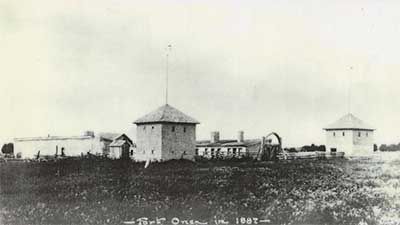The Bitterroot Valley was the traditional homeland of the Inland Salish Indians. A chance encounter between the Salish and the Lewis and Clark Expedition occurred in 1805 at Ross’ Hole in the southern Bitterroot Valley. The friendly Salish Tribe provided the Corps of Discovery food and supplies, plus guides through the rough mountainous terrain.
Each year, the Salish and the Nez Perce Tribes joined together to cross the Continental Divide for the buffalo hunts.
A dozen Iroquois Indians came into the valley with the Hudson’s Bay Company and introduced Christianity to the local tribes. Between 1831 and 1839 four separate delegations of Salish and Nez Perce Indians traveled to St. Louis to petition for Black Robes to live among them. Belgian born Father Pierre DeSmet, S.J., along with five missionaries were sent in response to the requests.

St. Mary’s Mission was founded on September 24, 1841 which established the first church and pioneer settlement, 48 years before Montana attained statehood.
The Missionaries introduced farming and animal husbandry along with Christian teachings.
Italian Father Anthony Ravalli, S.J. arrived in 1845. He was eager to embrace his assignment to serve among the Indian Tribes of the Rocky Mountain region. The beloved priest was Montana’s first physician, surgeon and pharmacist with additional skills of architect, artist, sculptor and engineer
The Salish embraced Christian values, many of which coincided with their own: generosity, community, obedience, burying their dead, and respect for family. However, the tribe did not understand the European social, political, and economic ideals that challenged their native views, and instead wished for the Christian power and protection to fit the tribe’s needs.
A larger church was under construction in 1846. Before it’s completion, problems with the Salish’s traditional enemies, the Blackfoot, forced what was intended to be a temporary closure of the Mission. By terms of a Conditional Bill of Sale in November 1850, John Owen, a former army sutler, bought the improvements for $250.00. Should the Jesuits return within two years the mills and fields would revert to them. When they were unable to return by the designated time, the Jesuits sent word to burn the church to save it from desecration. The former mission site became Fort Owen, a trading post.


In 1872, under U. S. Government pressure, the Salish began to leave their ancestral homeland for the Flathead Reservation. By 1891 the remaining Salish were destitute and suffering. Chief Charlo said, “I will go… My young men have no place to hunt… my women are hungry. For their sake I will go.”
Throughout difficult times of treaties, broken promises and a forged signature, the missionaries advocated for their Indian friends, writing letters to the government on behalf of the Salish leaders.
Old St. Mary’s stands as a monument to those heroic sons of the mountains, and to those dedicated Jesuits who were the pioneers of Montana’s pioneers.
Today the mission complex includes the restored chapel/residence, Father Ravalli’s log house/pharmacy and Chief Victor’s cabin (now a Salish museum). DeSmet park offers picnic facilities and a replica of a Salish encampment, the cemetery where Father Ravalli is buried and the Indian burial plot. A Visitor’s Center was added in 1996 and houses a gift shop as well as a research library, art gallery and museum that features some of Father Ravalli’s hand tools and farm equipment as well as historical documents and photographs. There is a diorama depicting Chief Big Face, Fr. DeSmet and Chief Victor and recently added is a replica of the first two-wheeled carts. The carts carried belongings and supplies for the first group of Jesuits as they were escorted by the Indians to the Bitter Root Valley in 1841.

